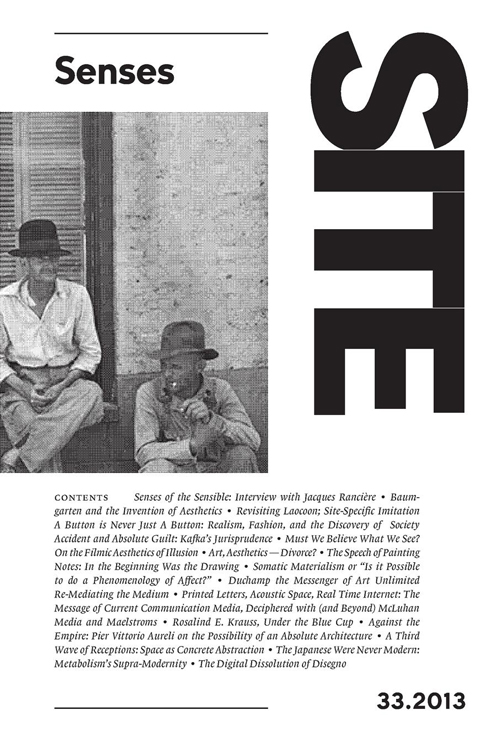33.2013
Senses
 Download
Download
Any definition of the aesthetic domain poses a challenge to thought: should aesthetics limit itself to the fine arts, and perhaps only to works that attain a particular and paradigmatic status, or should it aspire to formulate a general theory of what may count as an object of aesthetic appreciation, including everyday life and all aspects of our world that pertain to the senses? When the term aesthetics was coined in the first half of the eighteenth century, it was from the outset a multidimensional term, beset with tensions and conflicts — on the one hand a theory of the fine arts, which would coalesce into a “system” a few decades later; on the other hand, as was claimed by Baumgarten, who invented the term, an “art of thinking beautifully.” Aesthetics was partly a theory of a new class of objects, but more generally also a profound upheaval of rationalist philosophy that took its cues from a re-evaluation of the sensible. From the moment of its emergence, aesthetics has oscillated between a subordinate position in the philosophical encyclopedia and a claim to explore the dimension of sense as such, beyond all particular disciplinary demarcations.
The first section explores this question in the past and present, beginning with an interview with Jacques Rancière, whose Aisthesis: Scenes from the Aesthetic Regime of Art constitutes one of the most significant attempts in recent times to chart the emergence of a new distribution of the sensible from the eighteenth century onward. Continuing with essays that address crucial moments in the first phases of aesthetics — Baumgarten, who is currently being re-read as providing a general theory of sensibility (Sven-Olov Wallenstein), Lessing, who gives aesthetic pleasure a particular twist by connecting it to a dimension of pain (Cecilia Sjöhom), and the later intertwining of aesthetics and fashion (Sara Danius) — the section proceeds to discussions of modern artistic forms: the role of law and guilt in Kafka (Howard Caygill), the question of filmic illusion (Gertrud Koch), and the problem of whether art, and particularly the visual arts, can be understood at all on the basis of a generalized aesthetic (Morten Kyndrup). The status of a phenomenology of the sensible is at the center of the last three contributions, Pablo Bustinduy Amador’s essay on painting, Marcia Sá Cavalcante Schuback’s meditation on drawing, and finally Susan Kozel’s interrogation of the challenge put to a phenomenology of dance by new types of somatic materialism.
Another dimension of the senses, the sensory and the sensible is the necessary intertwining with technologies of perception, storage, and transmission. 2011 was the centenary of the birth of Marshall McLuhan, whose writings were paramount in bringing the idea of “media” to the forefront of culture, and the second section explores the ramifications of this concept in contemporary media and communication studies and art criticism. Drawing on material presented at a symposium at Moderna Museet, this section contains contributions by Thierry de Duve, on Duchamp and the question of art in general; by Richard Cavell, on McLuhan’s fundamental idea of remediation; by Wolfgang Ernst on the temporal structure of electronic media; by Staffan Ericson on the link between McLuhan and Walter Benjamin; and a review by Dan Karlholm of a recent book by Rosalind Krauss that develops her earlier analysis of the “postmedium condition” of the arts.
The third and final section contains a series of essays dealing with architecture and urbanism. Tim Anstey reviews a new book by Pier Vittorio Aureli on the possibility of an absolute architecture, Sten Gromark discusses Łukasz Stanek’s recent work of Henri Lefebvre, Sarah Stanley probes the modernity of Japanese Metabolism, and Staffan Lundgren provides a critical take on the ideologies of parametric design.
The Editors
Contents
Aisthesis
Senses of the Sensible: Interview with Jacques Rancière
By Sven-Olov Wallenstein and Kim West
Baumgarten and the Invention of Aesthetics
By Sven-Olov Wallenstein
Revisiting Laocoon; Site-Specific Imitation
By Cecilia Sjöholm
A Button is Never Just a Button: Realism, Fashion, and the Discovery of Society
By Sara Danius
Accident and Absolute Guilt: Kafka’s Jurisprudence
By Howard Caygill
Must We Believe What We See? On the Filmic Aesthetics of Illusion
By Gertrud Koch
Art, Aesthetics—Divorce?
By Morten Kyndrup
The Speech of Painting
By Pablo Bustinduy Amador
Notes: In the Beginning Was the Drawing
By Marcia Sá Cavalcante Schuback
Somatic Materialism or “Is it Possible to do a Phenomenology of Affect?”
By Susan Kozel
Media/Mcluhan
Duchamp the Messenger of Art Unlimited
By Thierry de Duve
Re-Mediating the Medium
By Richard Cavell
Printed Letters, Acoustic Space, Real Time Internet: The Message of Current Communication Media, Deciphered with (and beyond) McLuhan
By Wolfgang Ernst
Media and Maelstroms
By Staffan Ericson
Rosalind E. Krauss, Under the Blue Cup
By Dan Karlholm
Architecture and Urbanism
Against the Empire: Pier Vittorio Aureli On the Possibility of an Absolute Architecture
By Tim Anstey
A Third Wave of Receptions: Space as Concrete Abstraction. Łukasz Stanek on Henri Lefebvre
By Sten Gromark
The Japanese Were Never Modern: Metabolism’s Supra-Modernity
By Sarah Stanley
The Digital Dissolution of Disegno
By Staffan Lundgren
Issues
33.2013 Senses
31-32.2012 Remake Remodel
29-30.2010 Vanishing Points
28.2009 The Contagious Documentary
26-27.2009 Venetian Views
25.2009 Derrida’s Last Paths
24.2008 Residuals
22-23.2008 Spaces of Art
21.2007 Authentic Histories
20.2007 Reinventing Site
18-19.2007
16-17.2006
15.2005
13-14.2005
12.2004
11.2004
9-10.2004
7-8.2004
6.2003
5.2003
3-4.2002
2.2002
1.2001
Publisher and Editor in Chief
Sven-Olov Wallenstein
Editors
Tim Anstey, Brian Manning Delaney, Power Ekroth, Jeff Kinkle, Trond Lundemo, Staffan Lundgren, Karl Lydén, Helena Mattsson, Meike Schalk, Susan Schuppli, Kim West.
Contact
info@sitemagazine.net
Submissions
Text proposals to be sent to info@sitemagazine.net
© 2025
Graphic Design
Konst & teknik

